Conium maculatum
Conium maculatum, the hemlock or poison hemlock, is a highly poisonous biennial herbaceous flowering plant in the carrot family Apiaceae, native to Europe and North Africa. A hardy plant capable of living in a variety of environments, hemlock is widely naturalized in locations outside its native range, such as parts of North and South America, Australia and West Asia, to which it has been introduced.
| Conium maculatum | |
|---|---|
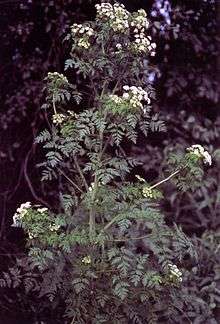 | |
| Conium maculatum in California | |
| Scientific classification | |
| Kingdom: | Plantae |
| Clade: | Tracheophytes |
| Clade: | Angiosperms |
| Clade: | Eudicots |
| Clade: | Asterids |
| Order: | Apiales |
| Family: | Apiaceae |
| Genus: | Conium |
| Species: | C. maculatum |
| Binomial name | |
| Conium maculatum L., 1753 | |
| Synonyms[1] | |
|
List
| |
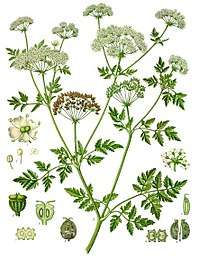
Description

Conium maculatum is a herbaceous biennial flowering plant that grows to 1.5–2.5 m (5–8 ft) tall, with a smooth, green, hollow stem, usually spotted or streaked with red or purple on the lower half of the stem. All parts of the plant are hairless (glabrous); the leaves are two- to four-pinnate, finely divided and lacy, overall triangular in shape, up to 50 cm (20 in) long and 40 cm (16 in) broad.[2] Hemlock's flower is small and white; they are loosely clustered and each flower has five petals.[3] The plant looks like the wild carrot plant (Daucus carota). One can tell apart (distinguish) the two by hemlock's smooth texture, mid-green, quite vivid, color and typical height of large clumps being least 1.5 metres, twice the maximum of wild carrot. Also, wild carrot has hairy stems that lack the purple blotches; hemlock's height is often reached instead by similar giant hogweed (Heracleum mantegazzianum) in the same family. It is less readily confused with harmless cow parsley, with very pale, weaker stems and tiny red-and-green leaves next to many of its flower stems which colonises bright areas (Anthriscus sylvestris).
It has become endemic in Asia, North America, Australia and New Zealand.[4][5][6] The plant is often found in poorly drained soil, particularly near streams, ditches and other watery surfaces. It also appears on roadsides, edges of cultivated fields and waste areas[4] and is considered an invasive species in 12 U.S. states.[7]
Conium maculatum grows in quite damp soil,[8] but also on drier rough grassland, roadsides and disturbed ground. It is used as a food plant by the larvae of some lepidoptera, including silver-ground carpet moths and particularly the poison hemlock moth (Agonopterix alstroemeriana). The latter has been widely used as a biological control agent for the plant.[9] Poison hemlock flourishes in the spring, when most undergrowth in other families is not in flower and may not be in leaf. All plant parts are poisonous, but cut and fully dried, the poison is reduced.
Distribution
It exists in some woodland (and elsewhere) in most British Isles counties;[10] in Ulster these are particularly Down, Antrim and Londonderry.[11]
Etymology of the name
The plant, due to its prevalence and danger in consumption, is generally referred to by its local name. Hemlock is, the main root word or whole word, the same in all Germanic and Nordic languages, also with some alternates such as poison hemlock, poison parsley, spotted corobane (rarer forms), carrot fern (Australian Eng.), devil's bread or devil's porridge (Irish Eng.)[6]
Conium comes from the Ancient Greek κώνειον – kṓneion: "hemlock". This may be related to konas (meaning to whirl), in reference to vertigo, one of the symptoms of ingesting the plant.[12]
The dried stems are sometimes called kecksies or kex.[13]
The plant should not be visually confused with the North American-native Tsuga coniferous tree, sometimes called the hemlock tree, fir or spruce, from a slight similarity in the leaf smell.
Similarly, the plant should not be confused with cicuta (commonly known as water hemlock). For the first of these, the ambiguous shorthand of 'hemlock' is more common than the latter "namesake".
Toxicity
The plant is poisonous to all mammals (and many other animals) that eat it. Studies have reported cases of intoxication in cattle, pigs, sheep, goats, donkeys, rabbits, and horses. Poison hemlock contains traces of other similarly poisonous alkaloids. Ingesting less than a tenth of a gram of coniine can be fatal for adult humans; this is approximately six to eight hemlock leaves. The seeds and roots are also toxic, more so than the leaves.[14] While hemlock toxicity primarily results from consumption, poisoning can also result from inhalation, and from skin contact.[15] Farmers also need to be careful that the hay fed to animals does not contain hemlock. Poison hemlock is most poisonous in the spring when the concentration of γ-coniciene (the precursor to other toxins) is at its peak.[16][17]
Poison hemlock grows quite tall, reaching heights of up to twelve feet (3.6 meters).[18] The stalk of hemlock is green with purple spots and completely lacks hair. A biennial plant, hemlock produces leaves at its base the first year but no flowers. In its second year it produces white flowers in umbrella shaped clusters.[19] Hemlock can be confused with the wild carrot plant; however, this plant has a hairy stem without purple markings, grows less than three feet tall, and does not have clustered flowers.[15] While the hemlock plant is native to Europe and the Mediterranean region,[20] it has spread to every other continent excluding Antarctica.[21]
Conium and other alkaloid toxins
-Coniine_Structural_Formula_V.1.svg.png)
C. maculatum is known for its poisonous characteristic. Its tissues contain different amount of alkaloids. In flower buds, the major alkaloid found is γ-coniceine. However, this molecule is transformed into coniine later during the fruit development.[23] The alkaloids are volatile; therefore, researchers assume that these alkaloids play an important role in attracting pollinators such as butterflies and bees.[24]
Conium contains the piperidine alkaloids coniine, N-methylconiine, conhydrine, pseudoconhydrine and gamma-coniceine (or g-coniceïne), which is the precursor of the other hemlock alkaloids.[4][25][26][27]
Coniine has a chemical structure and pharmacological properties similar to that of nicotine.[4][28] Coniine acts directly on the central nervous system through inhibitory action on nicotinic acetylcholine receptors. In high enough concentrations, coniine can be dangerous to humans and livestock.[26] With its high potency, the ingestion of seemingly small doses can easily result in respiratory collapse and death.[29]
The alkaloid content found in C. maculatum also affects the thermoregulatory center by a phenomenon called peripheral vasoconstriction, resulting in hypothermia in calves.[30] In addition, alkaloid was also found to stimulate the sympathetic ganglia and reduce the influence of the parasympathetic ganglia in rats and rabbits, causing an increased heart rate.[31]
One of the reasons poison hemlock is appealing to herbivores and other animals is its appearance. Poison hemlock leaves look similar to those of carrots or parsley; therefore, animals often mistake hemlock for common edible plants. Abundant in early spring, the somewhat bitter plant may be among few which remain, owing to its toxicity.
Coniine also has significant toxic effects on the kidneys. The presence of rhabdomyolysis and acute tubular necrosis has been shown in patients who died from hemlock poisoning. A fraction of these patients were also found to have acute kidney injury.[32] Coniine is toxic for the kidneys because it leads to the constriction of the urinary bladder sphincter and eventually the accumulation of urine.[33]
Toxicology
A short time after ingestion, the alkaloids produce potentially fatal neuromuscular dysfunction due to failure of the respiratory muscles. Acute toxicity, if not lethal, may resolve in spontaneous recovery, provided further exposure is avoided.
The onset of symptoms is similar to that caused by curare, with an ascending muscular paralysis leading to paralysis of the respiratory muscles, causing death from oxygen deprivation. Death can be prevented by artificial ventilation until the effects have worn off 48–72 hours later.[4] For an adult, the ingestion of more than 100 mg (0.1 gram) of coniine (about six to eight fresh leaves, or a smaller dose of the seeds or root) may be fatal.[34]
It has been observed that poisoned animals return to feed on the plant after initial poisoning. Chronic toxicity affects only pregnant animals when they are poisoned at low levels by C. maculatum during the fetus' organ-formation period, the offspring is born with malformations, mainly palatoschisis and multiple congenital contractures (arthrogryposis). The damage to the fetus due to chronic toxicity is irreversible. Though arthrogryposis may be surgically corrected in some cases, most of the malformed animals die. Such losses may be underestimated, at least in some regions, because of the difficulty in associating malformations with the much earlier maternal poisoning.
Since no specific antidote is available, prevention is the only way to deal with the production losses caused by the plant. Control with herbicides and grazing with less-susceptible animals (such as sheep) have been suggested. It is a common myth that C. maculatum alkaloids can enter the human food chain via milk and fowl, but scientific studies have disproven these claims.[35]
Historical and cultural references
Conium maculatum is the plant that killed Theramenes, Socrates and Phocion.[36] In ancient Greece, hemlock was used to poison condemned prisoners. Socrates, the most famous victim of hemlock poisoning, was accused of impiety and corrupting the minds of the young men of Athens in 399 BC and his trial gave down his death sentence. He decided to take a potent infusion of hemlock. Plato described Socrates' death in the Phaedo:[37]
The man ... laid his hands on him and after a while examined his feet and legs, then pinched his foot hard and asked if he felt it. He said "No"; then after that, his thighs; and passing upwards in this way he showed us that he was growing cold and rigid. And then again he touched him and said that when it reached his heart, he would be gone. The chill had now reached the region about the groin, and uncovering his face, which had been covered, he said – and these were his last words – "Crito, we owe a cock to Asclepius. Pay it and do not neglect it." "That," said Crito, "shall be done; but see if you have anything else to say." To this question he made no reply, but after a little while he moved; the attendant uncovered him; his eyes were fixed. And Crito when he saw it, closed his mouth and eyes.[38]
Socrates showed no fear drinking the poison given to him in a cup. He died after drinking it.
It is the perspective of Bloch that careful attention to Plato's words, modern and ancient medicine and other ancient Greek sources point to this account being consistent with such poisoning.[39]
Perhaps he was murdered via an extract from an Aconitum species, such as Aconitum napellus, rather than via Conium maculatum as it too was commonly used by the Greeks as an arrow poison but can be used for other forms of poisoning; it has been hypothesized that Alexander the Great was murdered via aconite.[40] Some readers attributing a precise account to all of the somewhat sketchy and not always faithful accounts have suggested the drink was heavily dosed with opium, due to no involuntary spasms nor sign of pain he showed.[40]
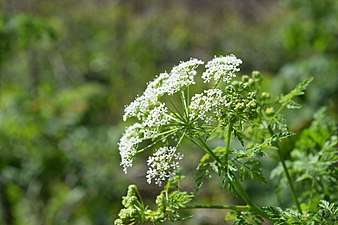 Poison hemlock
Poison hemlock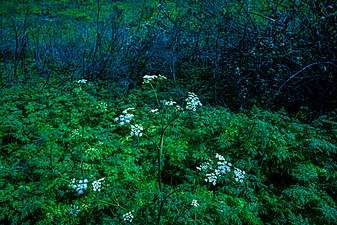 Conium maculatum in Chino, California
Conium maculatum in Chino, California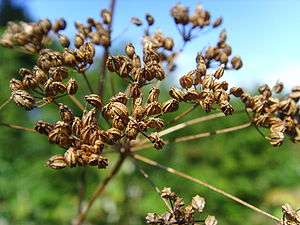 Hemlock seed heads in late summer
Hemlock seed heads in late summer The Death of Socrates, by Jacques-Louis David (1787)
The Death of Socrates, by Jacques-Louis David (1787)
See also
References
- Allkin, R.; Magill, R.; et al., eds. (2013). "Conium maculatum L." The Plant List (online database). 1.1. Retrieved January 23, 2017.
- [http://luirig.altervista.org/flora/taxa/index1.php?scientific-name=conium+maculatum Altervista Flora Italiana, Cicuta maggiore, Conium maculatum L. includes photos and European distribution map
- Holm, LeRoy G. (1997). World weeds: natural histories and distribution. New York: Wiley. ISBN 0471047015.
- Schep, L. J.; Slaughter, R. J.; Beasley, D. M. (2009). "Nicotinic Plant Poisoning". Clinical Toxicology. 47 (8): 771–781. doi:10.1080/15563650903252186. PMID 19778187.
- Zehui, Pan & Watson, Mark F. "31. Conium Linnaeus, Sp. Pl. 1: 243. 1753". Flora of China. Retrieved January 23, 2017. See also the substituent page: "1. Conium maculatum Linnaeus, Sp. Pl. 1: 243. 1753". Flora of China. Retrieved January 23, 2017.
- Atlas of Living Australia, Conium maculatum L., Carrot Fern
- "Poison hemlock, spotted hemlock – Conium maculatum". Map, where regarded invasive. National Park Service. Retrieved 2009-01-14.
- Online Atlast of the British and Irish Flora: Conium maculatum
- Castells, Eva; Berenbaum, May R. (June 2006). "Laboratory Rearing of Agonopterix alstroemeriana, the Defoliating Poison Hemlock (Conium maculatum L.) Moth, and Effects of Piperidine Alkaloids on Preference and Performance". Environmental Entomology. 35 (3): 607–615. doi:10.1603/0046-225x-35.3.607.
- Clapham, A.R.; Tutin, T.G.; Warburg, E.F. (1968). Excursion Flora of the British Isles (2nd ed.). ISBN 0521-04656-4.
- Hackney, P., ed. (1992). Stewart & Corry's Flora of the North-east of Ireland. Institute of Irish Studies and The Queen's University of Belfast. ISBN 0-85389-446-9.
- "Conium maculatum". Northwestern Arizona University. Retrieved 2012-07-06.
- "Kex". EtymOnline.
- "IPCS INCHEM: International Programme on Chemical Safety". Choice Reviews Online. 34 (11): 34–6285-34-6285. 1997-07-01. doi:10.5860/choice.34-6285. ISSN 0009-4978.
- DNRP-WLRD-RRS Staff (November 28, 2016). "Poison-hemlock". Noxious Weeds in King County, Weed Identification Photos. Seattle, WA: Department of Natural Resources and Parks (DNRP), Water and Land Resources Division (WLRD), Rural and Regional Services (RRS) section. Retrieved January 23, 2017.
- Cheeke, Peter (31 Aug 1989). Toxicants of Plant Origin: Alkaloids, Volume 1 (1 ed.). Boca Raton, Florida: CRC Press. p. 118. ISBN 978-0849369902.
- "Poison Hemlock: Options for Control" (PDF). co.lincoln.wa.us. Lincoln County Noxious Weed Control Board. Archived from the original (PDF) on 4 March 2016. Retrieved 3 May 2015.
- "Poison Hemlock". pierecountryweedboard.wsu.edu. Pierce County Noxious Weed Control Board.
- "Poison Hemlock" (PDF). store.msuextension.org. Montana State University. Retrieved 3 May 2015.
- Vetter, J (September 2004). "Poison Hemlock (Conium maculatum L.)". Food Chem Toxicol. 42 (9): 1374–82. doi:10.1016/j.fct.2004.04.009. PMID 15234067.
- Moser, L; Crisp, D. "Poison Hemlock" (PDF). San Francisco Peaks Weed Management. Retrieved 3 May 2015.
- Stephen T. Lee; Benedict T. Green; Kevin D. Welch; James A. Pfister; Kip E. Panter (2008). "Stereoselective potencies and relative toxicities of coniine enantiomers". Chemical Research in Toxicology. 21 (10): 2061–2064. doi:10.1021/tx800229w. PMID 18763813.
- Cromwell, B. T. (October 1956). "The separation, micro-estimation and distribution of the alkaloids of hemlock (Conium maculatum L.)". Biochemical Journal. 64 (2): 259–266. doi:10.1042/bj0640259. ISSN 0264-6021. PMC 1199726. PMID 13363836.
- Roberts, Margaret F. (1998), "Enzymology of Alkaloid Biosynthesis", Alkaloids, Springer US, pp. 109–146, doi:10.1007/978-1-4757-2905-4_5, ISBN 9781441932631
- Reynolds, T. (June 2005). "Hemlock Alkaloids from Socrates to Poison Aloes". Phytochemistry. 66 (12): 1399–1406. doi:10.1016/j.phytochem.2005.04.039. PMID 15955542.
- Vetter, J. (September 2004). "Poison Hemlock (Conium maculatum L.)". Food and Chemical Toxicology. 42 (9): 1373–1382. doi:10.1016/j.fct.2004.04.009. PMID 15234067.
- "Conium maculatum TOXINZ - Poisons Information". www.toxinz.com. Retrieved 2017-05-29.
- Brooks, D. E. (2010-06-28). "Plant Poisoning, Hemlock". MedScape. eMedicine. Retrieved 2012-03-02.
- Tilford, Gregory L. (1997). Edible and Medicinal Plants of the West. ISBN 978-0-87842-359-0.
- López, T.A.; Cid, M.S.; Bianchini, M.L. (June 1999). "Biochemistry of hemlock (Conium maculatum L.) alkaloids and their acute and chronic toxicity in livestock. A review". Toxicon. 37 (6): 841–865. doi:10.1016/s0041-0101(98)00204-9. ISSN 0041-0101. PMID 10340826.
- Forsyth, Carol S.; Frank, Anthony A. (July 1993). "Evaluation of developmental toxicity of coniine to rats and rabbits". Teratology. 48 (1): 59–64. doi:10.1002/tera.1420480110. ISSN 0040-3709. PMID 8351649.
- Note:acute tubular necrosis causes acute kidney injury. Rizzi, D; Basile, C; Di Maggio, A; et al. (1991). "Clinical spectrum of accidental hemlock poisoning: neurotoxic manifestations, rhabdomyolysis and acute tubular necrosis". Nephrol. Dial. Transplant. 6 (12): 939–43. doi:10.1093/ndt/6.12.939. PMID 1798593.
- Barceloux, Donald G. (2008), "Poison Hemlock (Conium maculatum L.)", Medical Toxicology of Natural Substances: Foods, Fungi, Medicinal Herbs, Plants, and Venomous Animals, John Wiley & Sons, Inc., pp. 796–799, doi:10.1002/9780470330319.ch131, ISBN 9780470330319
- "Conium maculatum L." Inchem. IPCS (International Programme on Chemical Safety). Retrieved 2012-07-06.
- Frank, A. A.; Reed, W.M. (April 1990). "Comparative Toxicity of Coniine, an Alkaloid of Conium maculatum (Poison Hemlock), in Chickens, Quails, and Turkeys". Avian Diseases. 34 (2): 433–437. doi:10.2307/1591432. JSTOR 1591432.
- Blamey, M.; Fitter, R.; Fitter, A. (2003). Wild flowers of Britain and Ireland: The Complete Guide to the British and Irish Flora. London: A & C Black. ISBN 978-1408179505.
- "Plato, Euthyphro, Apology, Crito, Phaedo". Archived from the original on 2012-07-20. Retrieved 2012-07-06.
- Plato, Phaedo 117e–118a. Translated by Loeb Classical Library (1990 ed.). Cambridge, Massachusetts: Harvard University Press. pp. 401–3.
- Bloch, E. (March 2001). "Hemlock Poisoning and the Death of Socrates: Did Plato Tell the Truth?". Journal of the International Plato Society. Archived from the original on 2017-04-07.
– An expanded version of this article was also printed in Bloch, E. (2002). Brickhouse, Thomas C.; Smith, Nicholas D. (eds.). The Trial and Execution of Socrates: Sources and Controversies. New York: Oxford University Press. ISBN 978-0-19-511980-0. - Hayes, Antoinette; Gilbert, Stephen (2009). "Historical milestones and discoveries that shaped the toxicology sciences". In Luch, A. (ed.). Molecular, Clinical and Environmental Toxicology. Volume 1: Molecular Toxicology. Experientia Supplementum. 99. Switzerland: Birkhäuser Verlag. pp. 6–7. doi:10.1007/978-3-7643-8336-7_1. ISBN 978-3-7643-8335-0. Retrieved 11 February 2020.
External links
| Wikisource has the text of the 1905 New International Encyclopedia article Hemlock. |
- "Conium". Flora Europaea. Royal Botanic Garden Edinburgh.
| Wikimedia Commons has media related to Conium maculatum. |